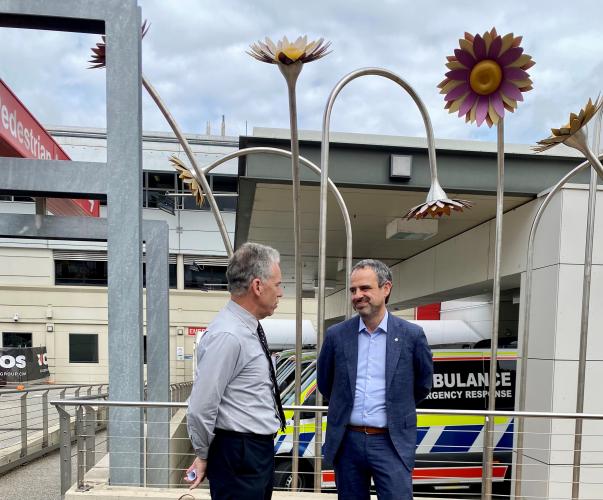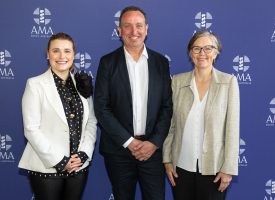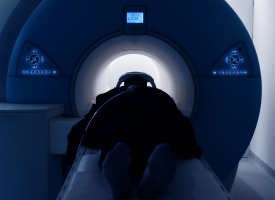AMA report paints worrying picture of failing Tasmanian public hospitals
AMA President launches Tas chapter of 2022 Public Hospital Report Card

Australian Medical Association (AMA) President, Dr Omar Khorshid, was today in Launceston to launch the Tasmanian chapter of the AMA Public Hospital Report Card 2022, highlighting a concerning picture of the state’s health system that should worry all Tasmanians.
Dr Khorshid outlined how Tasmania was underperforming in key areas of emergency department presentations and elective surgeries.
Dr Saul, AMA Tasmania Vice President adds, “the poor performance of Tasmanian hospitals was not confined to one or two hospitals.
“Tasmanians are waiting longer than they should for emergency treatment. Only 78 per cent of emergency patients (ED Triage Category 2, which includes immediate life-threatening presentations) were seen in the recommended time at the Mersey Hospital, 71 per cent at the North-West Regional Hospital and 63 per cent at the Launceston General Hospital.
“The Royal Hobart Hospital’s performance is particularly worrying, with only 46 per cent of ED Triage Category 2 patients seen on time. That is an awful lot of people not receiving timely care for conditions such as chest pain or severe pain, and often they are waiting and suffering in a ramped ambulance outside the hospital’s door,” Dr Saul said.
One in two Tasmanian patients who present to an Emergency Department (ED) with an urgent condition (ED Triage Category 3), such as severe abdominal pain for example, will have to wait longer than the clinically recommended 30 minutes to be seen by a doctor. That is 26 per cent below the best performing state and 14 per cent below the national average.
“These conditions can’t wait a long time – we are talking about heavy bleeding or major fractures. And, if your condition requires hospital admission, you’re likely to wait over 22 hours in ED before being admitted to a ward,” Dr Khorshid said.
He said Tasmania’s elective surgery waiting list is also one of the worst in the country and continues to get worse. In Tasmania, close to 60,000 patients are waiting to see a specialist in the public health system for their medical condition, an increase of almost 6,000 patients in one year.
Dr Saul said, “Only 63 per cent of patients at the Royal received their Category 1 elective surgery within the clinically recommended 30 days in 2020-21. These are urgent surgeries, such as limb amputations or the removal of malignant skin cancers. The LGH is barely any better with 64 per cent of Category 1 elective surgeries performed on time.
“Tasmanian patients also waited on average 65 days for Category 2 elective surgery – for surgeries such as a heart valve replacement or treatment of an unhealed fracture. This was 17 days longer than the national average and 37 days longer than the best-performing state.
“If you have a child with an ENT problem, such as reduced hearing, one that requires a simple procedure to rectify, the data suggest your child is likely to have to wait more than a year – 405 days – just to see a specialist. And they will wait possibly just as long to have the procedure. These are crucial days in a child’s development and the health system is failing them.”
Dr Khorshid said the AMA’s Clear the hospital logjam campaign aims to secure a new funding agreement to improve performance, expand capacity, address avoidable admissions, and end the funding blame game. This includes moving to a 50-50 funding agreement between State and Federal governments and removing the 6.5 per cent funding cap that constrains the ability of hospitals to meet community demand, which the AMA has costed at $20.5 billion over four years.
“In return, we’re asking state governments to commit to reinvesting every extra cent freed up by a move to 50-50 funding back into hospital capacity and performance improvement, in addition to their planned investments,” Dr Khorshid said.
“It’s critical and cannot wait any longer – we’ve got a 28 year-on-year decline in the number of beds per 1,000 Australians over the age of 65 years – our biggest group of hospital users. And Tasmania’s share is lower still, 13.2 per 1,000 population 65 years and over, 1.6 below the national average of 14.9,” he said.
Dr Khorshid said there was a limit to how far resources for our hospitals could be stretched.
“We need a long-term plan and a solution for our public hospitals. We have an ageing population whose demand for health care, including hospital care, will only increase. Our hospitals need to be funded to meet that demand.
“We are at a crisis point. Chances are you or someone you know will need to go to hospital at some point,” Dr Khorshid said.
“So, no matter our individual political persuasions, with the upcoming election the AMA is calling on voters and on political parties to put health first.” >>>(ENDS)
- The Tasmanian Australian chapter of the Public Hospital Report Card can be found here.
- The AMA’s Clear the Logjam campaign can be found here.
- Read the AMA’s Public Hospitals: Cycle of crisis report. The Four-point funding solution can be found here.
KEY STATS:
- With an average age of 42.6 years in 2021 and 21 per cent of its population over the age of 65, Tasmania has the oldest population in Australia.
- Tasmania’s bed ratio for population over 65 is 13.2 beds per 1000 people 65+, well below the national average of 14.9.
- Triage Category 3 (Urgent) Emergency department presentations (30 mins or less): 49 per cent of patients in Triage Category 3 in Tasmania were seen within the recommended time in 2020-21 reporting period.
- Emergency department presentations completed within 4 hours: In 2020-21, 58 per cent of emergency department visits were completed in four hours or less.
- Category 2 elective surgery wait times: In 2020-21, median wait in Tasmania was 37 days longer than the best performing State. On average, Tasmanians waited 65 days for Category two elective surgery.
- Category 2 elective surgery patients admitted within the recommended time (90 days): 36 per cent of patients (one in three) on Category 2 elective surgery waiting list were seen within the recommended 90 days in Tasmania. Tasmania is 51 per cent below the best performing state on this parameter.
- AMA Public Hospital Report Card shows that at least since 2013 Tasmania has been the worst performer on Category 2 elective surgery wait times and one of the worst performers on emergency department visits completed on time nationally.
- Despite an increase in population and growing ageing population, all four hospitals in Tasmania performed fewer Category 2 elective surgeries in 2020-21 than in 2011-12.
- Between 2013-14 and 2016-17 Category 2 elective surgery had been improving after more funding was made available under the original National Health Reform Agreement:
- increasing from 69% to 73% at the Royal Hobart Hospital,
- increasing from 79% to 83% at the Launceston General Hospital,
- increasing from 86% to 89% at the North-West Regional Hospital.
- Since 2016-17, after the 6.5 per cent cap on growth in Federal funding was introduced, the on-time performance of elective surgery has fallen. On-time Category 2 elective surgery performance is 41% at the Launceston General Hospital, 64% at the North-West Regional Hospital, 77% at the Mersey Hospital and only 40% at the Royal Hobart Hospital.
CONTACT:
AMA Tasmania: Nadine Cove – 0409 159 285
AMA Media (Federal): +61 2 6270 5478
+61 427 209 753
Follow the AMA Media on Twitter: http://twitter.com/ama_media
Follow the AMA President on Twitter: http://twitter.com/amapresident
Like the AMA on Facebook https://www.facebook.com/AustralianMedicalAssociation


